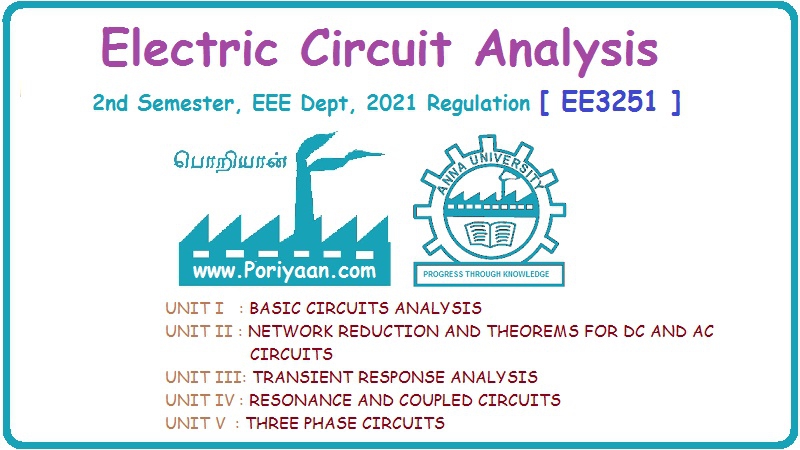Electric Circuit Analysis: Unit I: b. Basic circuits analysis
Solved problems on kirchoff's laws
Electric Circuit Analysis: Unit I: Basic circuits analysis : Solved problems on kirchoff's laws
SOLVED
PROBLEMS ON KIRCHOFF'S LAWS
Example
1 Find the current through 3 Ω resistor in the circuit shown.
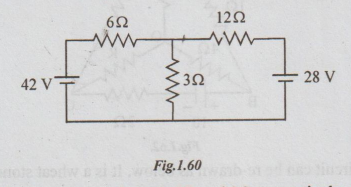
Solution:
Let I1 and I2 be the currents through 6Ω and 3Ω
respectively.
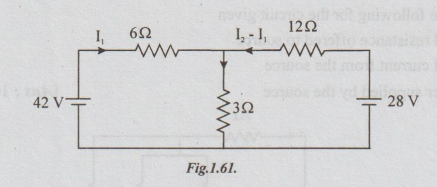
Then,
by KCL the current through
12
Ω = I2 - I1
Applying
KVL to the left loop we get
42-6I1-3I2
= 0
⇒ 6I1 +3I2
= 42
or
2I1+ I2 = I4... (a)
Similarly
applying KVL to the right loop,
12
(I2-I1)-28 +3I2 = 0
=>
- 12I1 + I512 = 28
⇒ -2I1 +2.5 I2
= 28/6 = 4.67...(b)
Adding
(a) and (b)
3.5I2
= 18.67
I2 = -5.33 A
Ans:
Current through 3 Ω = 5.33 A
Note:
Unless stated otherwise, go round the loop in clockwise direction.
Example
2 Find the value of R and the current flowing through it in the circuit shown
when the current in the branch OA is zero. A
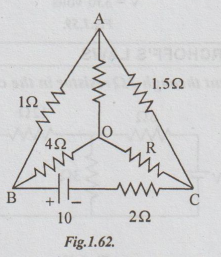
Solution:
The given circuit can be re-drawn as below. It is a wheat stone bridge.
As
the current through the branch OA is zero, the bridge is said to be under
balanced condition. Then product of resistances of opposite arms must be equal.
1 × R = 4 × 1.5
⇒ R = 6 Ω
When
the current through OA is zero, remove OA.
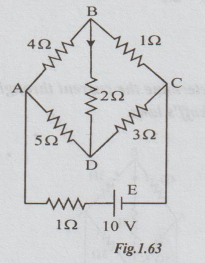
Then the circuit becomes as
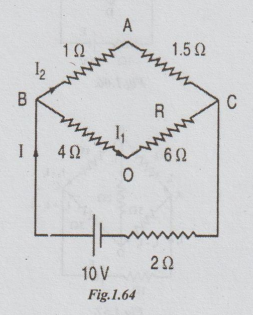
2.5
and 10 are in parallel. Total resistance of the circuit
RT
= 2.5 × 10/ 2.5 + 10 + 2 = 2 + 2 = 4
Ω
Source current IS = V/RT =
10/4
IS
= 2.5A

IS
is divided into two paths.
By
division of current formula I1=ISR2/R1+R2
=
2.5 ×
2.5/10 + 2.5 = 0.5A
Current
through R = 0.5 A
Ans:
R =6 Ω,
I6 = 0.5 A
Example
3 In the circuit shown, determine the current through the 2 Ω
resistor and the total current delivered by the battery. Use Kirchoff's laws.
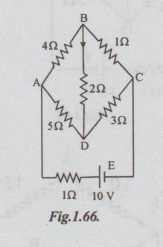
Solution:
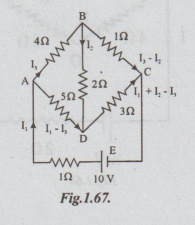
Let
I1 = current from the battery
I2
= current through 2 Ω
I3
= current through 4 Ω
The
currents in other resistors are obtained by applying KCL at nodes A, B and C.
By applying KCL at D, we can check the expressions.
Applying
KVL to the loop ABDA,

Ans:
I1 = 2.49 A, I2 = 0.281 A from D to B.
Example
4 Obtain the potential difference Vxy in the circuit shown in the fig1.68.
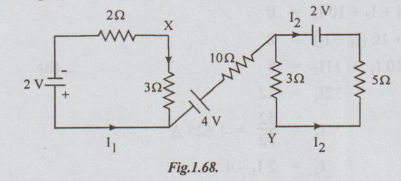
Solution:
As 4 V source does not have return path, there is no current from 4 volts.
Applying Ohm's law, to left and right loop to get,
I1=
2/2+3= 0.4
I2=
2/3+5 = 0.25 A
VXY
= p.d. between X and Y
=
3I1 + 4-3I2
=
3 × 0.4 + 4-3 × 0.25 = 5.2-0.75
=
4.45 volts with y + ve
Example
5 Two batteries A and B are connected in parallel and a load of 10
Ω
is connected across their terminals. A has an emf of 12 V and internal
resistance (I.R) of 2 Ω B has an emf of 8 volts and I.R of 1 Ω Using Kirchoff's
laws, determine the values and directions of currents in each of the batteries
and in external resistance. Also determine the potential across the external
load.
Note:
When
the statements are given (instead of circuit) the reader must be careful in
drawing the circuit correctly.
Batteries
are said to be in parallel if terminals of same polarities are joined together.
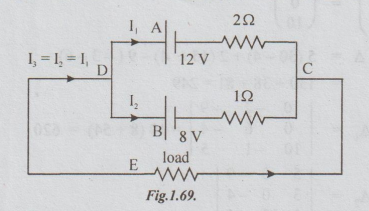
The
circuit is shown in the figure 1.69
Let
the currents in the batteries be as indicated in the figure.
By
KCL, the current through
10
Ω
= I3 = I1 +I2
Applying
KVL to the loop DACBD.
-
12 + 2I1 - I2 + 8 = 0
or
2I1 - I2 = 4....(1)
Applying
KVL to the loop DBCED, we get
-8
+ I2 + 10 I3 = 0
⇒ I2 + 10 (I1
+ I2) = 8
10
I1 + 11I2 = 8....(b)
(a) × 11+ (b) ⇒ 32I1 = 52
I1 = 52/32 =1.625 A
From
equation (a),
I2
= 2I1-4
=
2 (1.625)-4 = -0.75 A
I3
= I1 + I2 = 1.625-0.75 = 0.875
p.d.
across the load = V10 = I3 × 10
=
0.875× 10 = 8.75 V
with
D at +ve and C at -ve.
Ans:
I1 = 1.625 A; I2 = -0.75 A; I3 = 0.875 A; V10
= 8.75 V
Example
6 A network of resistors has a pair of input terminals AB connected to a d.c.
supply and a pair of output terminal CD connected to a load resistor of 602 The
resistances of the network are AC = BD = 90 Ω, AD = BC = 40 Ω Find
the ratio of the current in the load resistor to that taken from supply.
Solution:
The
network is drawn below. Let V be the supply voltage connected between the input
terminals A and B.
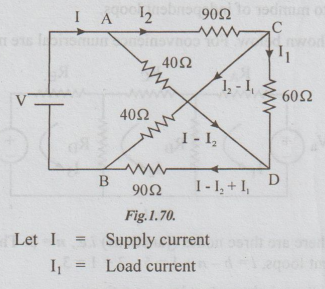
It
is required to find I1/I
Let
the current through branch AC be I2. The other branch currents are
expressed by applying KCL.
Applying
KVL to the loop ACDA, we get

Minus
sign indicates that the direction of I1 is from the terminal D to C
and not from C to D.
I1/I
= 0.2
Or
I1 = 0.21 = 20% of 1
Electric Circuit Analysis: Unit I: b. Basic circuits analysis : Tag: : - Solved problems on kirchoff's laws
Related Topics
Related Subjects
Electric Circuit Analysis
EE3251 2nd Semester 2021 Regulation | 2nd Semester EEE Dept 2021 Regulation
